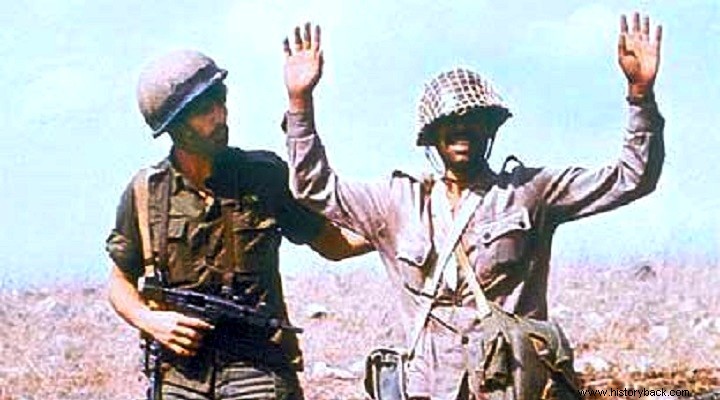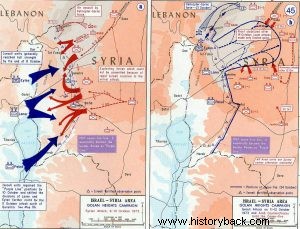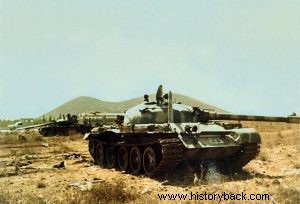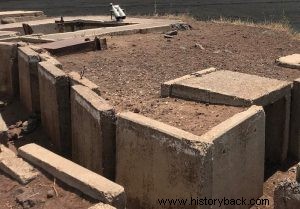
After their victory in the Six Day War in 1967, the Israelis enjoyed a sense of security. But everything was to be turned upside down in 1973 when the Arabs attacked en masse and by surprise. In the Golan the Israelis had fortified the controlled territory.
They had created a deep anti-tank ditch 4m deep and 6m wide. The Israelis had built a series of 17 outposts and 112 other fortified positions.
The opponents
Masses of mines protected the entire site. Behind each support point three tanks were deployed in prepared positions, while further back, as a last reserve, were stationed two Armored Brigades (PTB), the 7th and the 188th, with a total of 177 tanks. The men manning the support points belonged to the 13th "Gideon" Battalion of the "Golani" Brigade (TG). As for the artillery, 44 guns supported the site.
Opposite, the Syrians, as part of "Operation 110", planned to attack with three reinforced Infantry Divisions (5th, 7th, 9th) and two Armored Divisions (PT), the 1st and 3rd. In total they would throw into battle 70,000 men (28,000 motorized infantry) and 1,400 tanks, supported by 950 artillery elements, covered by 100 surface-to-air missile artillery.
Outpost 107 was one of the small flag supports. On October 6, 1973 it was manned by Lieutenant Elimelech and his 19 men. From the opposite side, the Syrian 85th Infantry Brigade and the 1st Mechanized Brigade were closing in on them. The few Israelis had the support of three tanks of the 74th Brigade of the 188th TTHT "Barak".
Attack
At 13.50 on 6 October a storm of artillery fire swept through the Israeli positions. Elimelech was outside the fortified outpost trying to get word of the situation by radio. As soon as the artillery fire came the Israeli lieutenant had through his binoculars masses of enemy tanks approaching from the direction of Damascus.
The three tanks supporting outpost 107 opened fire from a distance of 1,800m. These tanks under the lieutenant Jakin caused losses disproportionate to their number to the Syrians. Seven more Israeli tanks soon arrived on the scene and caused terrible bleeding to the opponents, who for their part failed to score a single blow.
Despite this, the Syrian tanks continued, as if hypnotized, their movement, simply bypassing the burning friendly tanks. Only after they lost 30 tanks the Syrians turned south, out of range of the Israelis. In other parts of the Israeli front, however, the situation became critical.
In the evening the Syrians returned and approached within 300m. from the outpost 107. Elimelech marked a target for Jachin's chariots. The Israeli charioteers as well as the men of the outpost opened fire causing terrible losses to the enemy, who stupidly insisted on moving in very vulnerable formations. Nevertheless, the situation for the few of the outpost was not rosy, lacking artillery and air force coverage, due to the development of operations.
The next day, Elimelech spotted enemy infantry at a distance of 1,500m. Yakin's three tanks opened fire on the Syrians when they got within about 500 meters, alongside the outpost's machine guns. Dozens of Syrians were harvested. The rest slowly retreated. They made no attempt to maneuver, and were also not supported by their chariots.
In the afternoon seven Syrian T-54/55 tanks moved directly against the outpost. Elimelech called for help and six I-Sherman tanks (World War II Shermans equipped with a modern cannon) rushed to the outpost. After this the Syrians retreated, but all the Israeli chariots also left, leaving the men of the outpost completely alone.
In the evening a Syrian tank accompanied by a personnel carrier approached the outpost. A combat team disembarked from the Syrian Womb and moved towards the barbed wire of the outpost. An Israeli soldier, Yosef Zadok, however, rushed forward and, without cover, fired an anti-tank launcher at the Syrian tank, destroying it. At the same time Sergeant Avidan opened fire on the Syrian soldiers, killing five of them. The living boarded the TOM and drove away. Another approaching TOM hit a mine and was destroyed with no survivors.
Siege
The next day after heavy artillery bombardment. In the meantime the Israeli defenses had broken elsewhere and post 107 could now be attacked from any direction. Elimelech organized a perimeter defense. He had at his disposal four machine guns, a portable anti-tank launcher and his men's individual weapons, FN assault rifles and UZI submachine guns.
As this was happening a Syrian tank approached but hit a mine and was destroyed. The survivors of the chariot jumped out waving white handkerchiefs and headed towards the guardhouse shouting that they were Syrian Jews forcibly rounded up. In the evening Elimelech was ordered to abandon the garrison and retreat. At the same time, 200m. north of the outpost new Syrian force appeared. The Israelis did not open fire and the Syrians simply passed. Elimelech did not leave the guard. After all, he knew that there were Syrians everywhere.
The next morning, a Syrian tank managed to destroy all four machine guns of the outpost with its fire. When the tank left the Israelis came out of the outpost and searching the damaged Syrian tanks removed any weapon that was in working order. They found machine guns, assault rifles and anti-tank launchers.
But all this was little in the face of the new wave that was coming against them. The Syrians were carrying out a new large-scale attack with the 7th and 9th MP supported by 70 T-62 tanks of the Presidential Guard . Private Zaktok managed to destroy five of them in a few moments, before being seriously injured. It is worth noting that the Syrians did not attempt to capture the outpost and despite the losses they suffered simply continued to move towards Israeli territory.
In the meantime the "Gideon" Battalion having lost contact with the outpost sent a force to ascertain the situation and was able to rescue the besieged. Three Israeli tanks and two M3 half-tracks with soldiers, under Lt. Col. Nafsi, constituted this power. Nafsi's division managed to break through the Syrian lines and reached Outpost 107. The men of Outpost 107 had been saved.
At the same time, the great Syrian offensive gradually degenerated. The Israelis' only loss, the severely wounded Joseph Zadok, survived.


Syrian abandoned tanks.

Israeli stronghold in the Golan, a remnant of the war.
